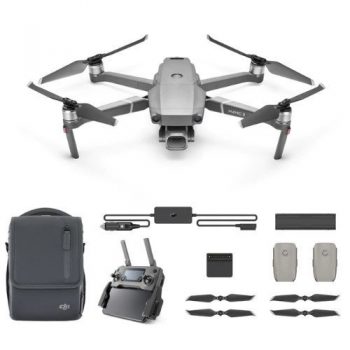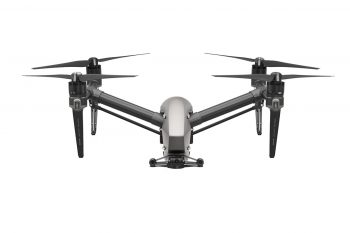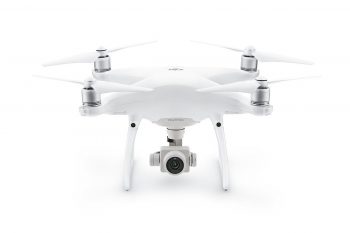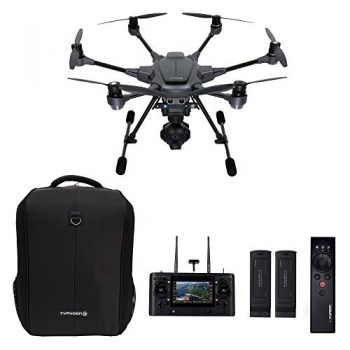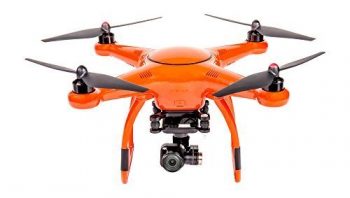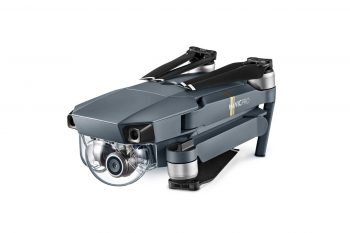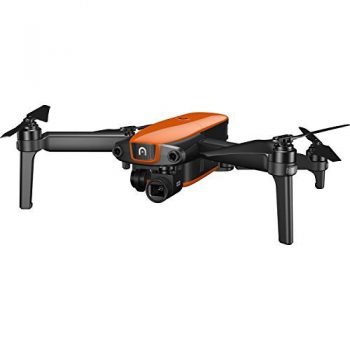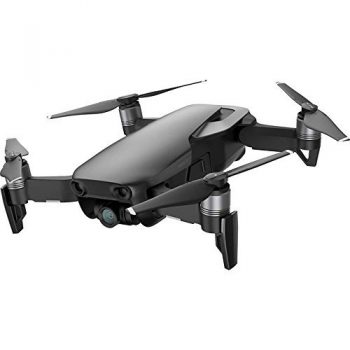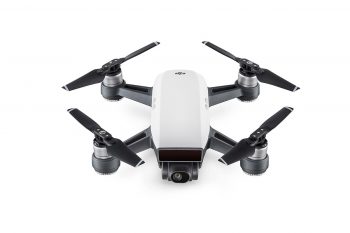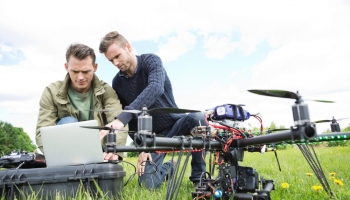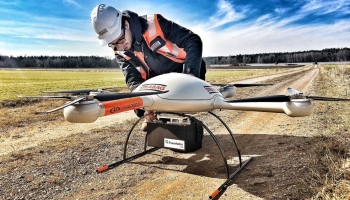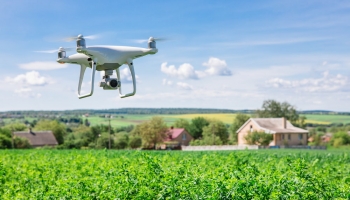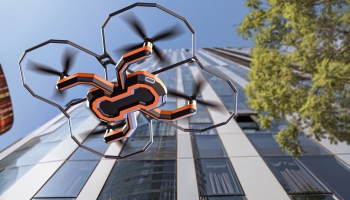As the drones continue to evolve at a breakneck pace, they are getting smarter and advanced with brand new sensors, faster processors, and even more features to process data in real-time. Almost all professional-grade camera drones that you are going to see are outfitted with obstacle collision avoidance features. That is one of the most important features that improve the drones’ ability to navigate in real-time.
The built-in vision sensors serve the role of an additional layer of protection. This process occurs in scanning the objects and relaying the information back to the processors which then automatically makes the decisions for the drone. The collision avoidance feature is an incredibly powerful tool that minimizes the human pilot’s errors. However, that doesn’t mean you should fly care-free. After all, it is possible to make a simple pilot error if you are not being careful.
As drone technology is changing the way of aviation. Flying the smart camera drones has never been that easier and safer than ever before. Even a beginner without prior flying experience can pick one of these popular drones under $1000 for beginners like the Phantom 4 or Mavic Pro. This is why you will find my top 10 best drones with collision avoidance features helpful in starting your own drone business or to fly recreational.
Before we dive into the top 10 best drones with collision avoidance features. I want to provide you an interface of what exactly is obstacle avoidance and how it works. As you read about the role of collision avoidance feature in these professional-grade camera drones. You will understand why it is important and how you will benefit from operating drones with this feature. If you have prior knowledge of obstacle avoidance systems, you can click here to start browsing the top 10 best drones with collision avoidance features for beginners.
Top 10 Best Drones With a Collision Avoidance System
Mavic 2 Pro
Overview:
The Mavic 2 Pro is the latest iteration of ultraportable and smart camera drones with foldable motor arms. It has a unique designed professional-grade camera called the Hasselblad. That camera features 20MP and 1-inch CMOS sensor that allows you to capture stills at a mouthwatering 5.6K resolution size.
Which makes the Mavic 2 Pro one of the easiest entry-level for professionals and beginners who are looking for a high-quality smart camera drone, to begin with. Along with the Fly More Combo kit, you can triple your total flight session with an all-powerful intelligent flight battery. The Mavic 2 Pro isn’t your average camera drone out of the mill standard.
Camera:
This model of Mavic 2 comes with Hasselblad camera mounted on a 3-axis gimbal stabilizer. One of the main advantages that the Mavic 2 Pro has over most of the drones is its flexibility and the ability to capture beautiful stills with high and precise details. Although, the camera still captures 4KUHD footage at 30 frames per second.
This puts the Mavic 2 Pro slightly below the top competitor for beginners, the Phantom 4 Pro. However, if you are looking for a compact drone that is easy to carry around and somewhat impressive durable. You shouldn’t worry too much about the camera’s specifications as they are actually good enough for producing video content.
Features:
The Mavic 2 Pro introduces a lot of amazing new features such as ActiveTrack 2.0 and OcuSync 2.0. Basically, the ActiveTrack 2.0 is an upgrade and successor of the original version that includes predictable trajectory and accurate targeting thanks to improved real-time mapping. Furthermore, the OcuSync 2.0 improves signal frequency that enables maximum remote control distance up to 5,000 meters.
The drone’s main body is rectangular and compact, with the camera and gimbal positioned at the lower frontal part of the drone. These benefit from an elevated position, especially when the drone is on the ground, so you have ground clearance for landing and take-off. Though it doesn’t have enough space so, for example, during landing or taking off on wet grass, make sure to provide a landing mat so that the camera’s lens won’t get wet as the gimbal calibrates once the drone is on.
In addition to that, the Mavic 2 Pro introduces a self-heating battery that allows you to fly the drone up to 31 minutes per charge. This foldable quadcopter also has zoom capabilities. Although it is somewhat limited compared to the Mavic 2 Zoom since it only can zoom up to 2.8 times closer. Learn more about the difference between Mavic 2 Pro and Mavic 2 Zoom.
Key Specifications:
- Flight Time: 31 Minutes
- Top Speed: 45 Miles Per Hour
- Control Range: 5 Miles / 8,000 Meters
- Camera Quality: 20 MP
- Resolution 4K @ 30 FPS
Mavic 2 Zoom
Overview:
The Mavic 2 Zoom is basically the same as Mavic 2 Pro, except it uses a different camera. While this model focuses on being the most portable and advanced camera drone designed for beginners and professionals. It comes with a camera that is basically the same one that Mavic Pro uses. However, it has the ability to zoom hence the name of its model, “Mavic 2 Zoom.”
This foldable camera drone is designed for beginners and professionals who want to be able to enjoy flying in the outdoor. With its zoom capabilities, you can take close look at pretty much everything that is otherwise impossible or dangerous to operate the drone. A battery pack lasts for 31 minutes and we highly recommend purchase Fly More Combo kit to triple your flight session.
Camera:
Now that we are talking about the camera specifications that the Mavic 2 Zoom uses. This camera drone is packed with a 12MP 1/2.3-inch CMOS sensor camera mounted on a 3-axis gimbal stabilizer. Thanks to gimbal stabilizer, you can easily point the camera in any direction you want to from sideways to upward and downward.
While the drone still produces 4K stills and 4KUHD footage at 30 frames per second. It comes with minor upgrade: dolly zoom. The Mavic 2 Zoom can zoom up to 4 times closer without losing the image quality. All to the digital image lossless technology, it works by maintaining the focus without impacting the quality of the image (See how Mavic 2 digital lossless image technique works).
Though professional drone photographers may choose the Mavic 2 Pro over the Mavic 2 Zoom, that doesn’t mean this one isn’t a great camera drone, because it still is. Considering its unique and excellent zoom lens and omnidirectional avoidance system, this drone is still a good choice, years after its release. Not to mention that it’s a bit cheaper than its twin brother.
You can beautifully capture aerial stills and videos of a subject up close at a great level of detail. Furthermore, if you become a skilled remote pilot, you can master the effect of zoom to create immersive and dazzling video content. The skill level cap with Mavic 2 Zoom is quite high compared to the Mavic 2 Pro which provides you with plenty of training to master the art of video content marketing.
Features:
Of course, the Mavic 2 Zoom has a bunch of awesome features as the Mavic 2 Pro does. The two most noticeable features that you should know right away are the ActiveTrack 2.0 and OcySync 2.0. These features improve the Mavic 2 Zoom’s aerial capabilities by obtaining much more accurate and precise flight control.
In addition to that, the Mavic 2 Zoom has a maximum remote control distance of up to 8,000 meters or 5 miles. If you truly want to have the ultimate flight experience, I recommend you to buy the DJI Smart Controller for a smoother signal connection. Furthermore, it reduces the time to take off and ensures you are operating at maximum efficiency.
Aside from that, pretty much the majority of the features are designed to provide you flight experience that is done automatically. Such as intelligent flight modes, automatic takeoff/landing, smart functions, and more. With the Mavic 2 Zoom drone, you can rest at the east knowing you are commanding an advanced camera drone with a 360-degree collision avoidance feature.
Key Specifications:
- Flight Time: 31 Minutes
- Top Speed: 45 Miles Per Hour
- Control Range: 5 Miles / 8,000 Meters
- Camera Quality: 12 MP
- Resolution 4K @ 30 FPS
Inspire 2
Overview:
The DJI Inspire 2 is a large and powerful bird equipped with an incredible mountable 3-axis gimbal camera. It also comes with a second camera which is located on the front to provide the remote pilot an aerial overview. Professional remote pilots and those from film making industries are the ones who prefer using this drone.
But Inspire 2 is also one of the most expensive drones. With different bundles to choose from, the Premium Combo (See Price) is the ultimate bundle deal to top the deck out. This is not your everyday average drone to fly around for recreational purposes and will require at least serious investments that you can upgrade over time.
Camera:
With a basic bundle, you get an Inspire 2 drone equipped with a two-axis camera. While you can’t really do a whole lot with that, it is highly recommended that you go for a more expensive bundle deals with Zenmuse camera. The starter bundle will get you a mountable 3-axis gimbal camera that captures still on 20 MP and records videos on 4K at 60 frames per second.
However, you will have the option to upgrade the camera up to a mouthwatering 6K resolution at 24MP image quality. The Zenmuse X7 camera comes at a steep price tag which isn’t something that you should take it lightly at all.
Whether you are flying it for making movies or photography, the Inspire 2 will certainly catapult you ahead of your competitors with its incredible and sturdy design. Coupled with a powerful and intelligent camera, you will be producing quality aerial films in no time.
Features:
One of the key features that Inspire 2 uses is self-heating technology. The batteries take advantage of that feature to keep them warm especially during the wintertime. Drones that uses standard Li-Po batteries will likely shut off because the extreme cold weather will cause them to interpret the batteries as dead.
But that is not the case with Inspire 2. With the self-healing technology, you can fly in some of the most remote and cold areas without any issue. Moreover, the Inspire 2 heavyweight and sturdy design allow it to fly at high altitudes. This creates the perfect opportunity for incredible aerial shots that will transforms your basic shots into a professional level.
Furthermore, Inspire 2 has equipped with three direction sensors. First and foremost, it has sensors on the front and bottom which are based on ultrasonic. Lastly, it has sensors on the top however they are infrared as contrasted to other sensors. It is actually a nice additional feature to help the large bird avert crashing against the ceiling.
Though, it must be noted that the Inspire 2 doesn’t feature obstacle detection sensors on its sides and rear parts. You may feel that this is an oversight for a top-tier drone brimming with sophisticated features such as this. So take that into consideration, as its one of the expensive drones available in the market.
Key Specifications:
- Flight Time: 27 Minutes
- Top Speed: 58 Miles Per Hour
- Control Range: 4.3 Miles / 7,000 Meters
- Camera Quality: 20 MP / 24 MP
- Resolution 4K @ 60 FPS / 5.2K @ 60 FPS / 6K @ 60 FPS
Phantom 4 Pro
Overview:
The DJI Phantom 4 Pro is everybody’s favorite drone. Don’t get me wrong, but it is a serious contender against the DJI Inspire 2 when it comes to aerial photography. The Phantom 4 Pro is equipped with a powerful 3-axis gimbal camera featuring 20MP and 1-inch CMOS sensor. It is incredibly capable of capturing stills and recording videos on 4K resolution at 60 frames per second.
With quite a powerful camera, it makes the whole post-procession much easier and less time-consuming. Although while Inspire 2 is widely used in professional fields, the Phantom 4 Pro has proven to be a potential competitor. This is a drone that fits all types of pilots, whether you are a first-time flyer or an experienced pilot looking to upgrade.
Design & Performance:
When it comes to the design and appearance of Phantom 4 Pro. It wins hands down because of the friendly approach that many people perceived it. Unlike the flying beasts such as Inspire 2 and DJI Mavic Pro, the Phantom 4 Pro features a smooth, futuristic-like hull that goes soft on bystanders.
Furthermore, the landing legs mounted on the drone provides support for safe landing as well as protecting the camera from touching the ground. The latest upgrade adds an all-around collision avoidance detection system. There are sensors located on the front, bottom, rear, and sides that provide you complete protection from flying into obstacles.
Even with the upgrades, it is still highly recommended that pilots pay attention to their drones. As the sensors can’t pick up objects fast enough when you are flying the drone too fast. But, we think at this price range, the DJI Phantom 4 Pro is a killer for beginners and professional pilots.
Features:
The DJI Phantom 4 Pro is one of the easiest drones to fly. The controls are simple, yet intuitive that provides you a complete overview of how to fly a drone. If you use your smartphone or tablets, you can gain access to additional features like intelligent flight modes. These features allow you to perform preset flight modes and even follow me mode.
Phantom 4 Pro’s obstacle avoidance technology is still one of the best in the market. It features a variety of sensors, both diverse and highly-effective. Located in the forward and backward directions are stereo vision sensors with the ability to detect obstacles up to 98 feet. Both sides of the drone also have infrared sensors that are sensitive up to 23 feet. Lastly, it has another infrared sensor on its belly to avoid landing on uneven terrain.
A single battery charge gives you a total flight time of 30 minutes. Realistically, you will be able to fly it for up to 25 – 26 minutes. Depending on how aggressive you are flying the drone and weather conditions. While the Phantom 4 Pro is obviously larger than DJI Mavic Pro and smaller than Inspire 2. It has a lot of features that will take you at least a few weeks to learn all of it.
back to menu ↑Yuneec Q500 4K Typhoon Quadcopter
Overview:
Another drone with collision avoidance that has made into the spotlight is the Yuneec Typhoon H Pro. Yuneec is one of the longest and first company to pioneer in electric aviation. Like everyone other drones, the Typhoon H Pro focuses on improved stability and longevity.
Perhaps one of the most notable designs that this drone has marked itself apart from its competitors is six motor arms. Indeed, it is not called quadcopter but a hexacopter. What makes a hexacopter better than a quadcopter is its incredible stability and the ability to fly at high altitudes without fighting against the wind too much.
One of its key features is that if a motor arm all of sudden stopped working, the other five motor arms will continue to run and the drone will stay in the air. With a quadcopter, it will drop onto the ground if a motor arm stopped working. That design provides Typhoon H Pro additional safety in terms of flight navigation.
Camera:
At the price tag, there is quite a lot to be said. It is mostly focused on longevity and stability. But only a little did they invested in improving the camera quality and making it kickass. The drone features a 360-degree rotatable 3-axis 12MP 1.2/3-inch CMOS sensor that can be mounted.
This allows you complete control of where you want the camera to point at. However, you will have the option to upgrade the drone with the RealSense feature. Basically, what it does is allowing the drone the ability to 3D map out the objects and store them in the memory. The next time drone flies back, it will remember and know where the objects are so that they can safely avoid. It is a drone that can learn on its own automatically.
Key Specifications:
- Control range: 1.6 Kilometers
- Material: Carbon Fiber
- Video Resolution: 3840x2160p
- Slow Motion: Yes (1080p @ 120 fps)
- Type: Hexacopter (6 Rotors)
- Wind resistance: 35mph
- Speed: 30 mph
- Safety features:
- Geo-fencing
- Dynamic return-to-home
- 5 Rotor fail-safe
- Low-Battery Return Home
- Variable Speed Control
Other Features:
A major advantage that the Yuneec Typhoon H Pro has is the built-in LCD screen on the remote controller. It basically fulfills all the features and flight modes that you can perform with the Typhoon H Pro. Not just only you can do more with a drone and remote controller, it eliminates the need to have a mounted smartphone or tablet. With the remote controller, you can easily fly the drone up to 1,600 meters away. It is possible to fly much further under great conditions and with a signal range extender.
A battery-only provides this drone a flight time of 25 minutes. That is 5 minutes less than the famed DJI Phantom 4 Pro. However, it is perfectly understandable considering the fact that it is actually a hexacopter. Six motor arms mean it needs more power to support the propellers. And more power means the battery gets drained quite fast. At that price tag, it is actually pretty fair and reasonable for high quality and stable drone. The Typhoon H Pro is not the most popular choice among beginners, but it is great for professionals.
back to menu ↑Autel X-Star Premium
The Autel X-Star Premium is another serious contender that is making a nosedive into the consumer market. Relatively new to the market, they have made great strides. They are well known for their exceptional customer services and top-notch quality that they have in the store. Because of that, some of the customers who bought Autel X-Star drone switched over from DJI and Yuneec.
Even though the Autel X-Star Premium is outfitted with a similar design of Phantom 4 Pro, it comes in two colors: white and orange. Underneath is a mountable 3-axis gimbal for the 12MP camera. It doesn’t exactly sport the same quality and powerful features that the Phantom 4 Pro has.
However, it is very capable of recording videos on 4K @ 40 frames per second, among other options, which is quite impressive for an affordable drone. THe X-Star Premium has a 108-degree field of vision as well. With this drone, you have the option to record videos at 720p 240fps, 1080p 120fps, or 2.7k 60fps. If you want to take 12MP still shots, you can do that with this drone too.
A single battery on average gives you a flight time of 25 minutes, which is the same for Typhoon H Pro. However when you take all of this into account such as low battery warning and the like. You will only be able to fly it for realistically an average of 21 to 22 minutes. That is not actually bad for a professional tier quadcopter.
Moreover, the Autel X-Star Premium is equipped with a collision avoidance detection system. They are located on the landing legs, unlike the ones that were implemented on the Phantom 4 Pro. The Autel X-Star Premium only can see forward and backward. It also can see up to a certain portion of the sides. But the sides are not entirely protected so the pilots will have to pay attention when flying the drones sideway. Also, you only can fly the Autel X-Star drone at a maximum speed of 33 miles per hour with a control range of 2,000 meters.
Overall, we think the Autel X-Star Premium is a hot affordable quadcopter to start with. With a strong customer service support center ready to answer any questions that you may have. This drone may not have the same quality in terms of features that the famed Phantom 4 Pro does. But it surely is a strong contender for those who prefer to get started with aerial photography and the like.
back to menu ↑Mavic Pro
Another wildly popular quadcopter is the DJI Mavic Pro. This foldable drone takes on the concept of compact, portability, and lightweight. It is also one of the first to be designed mainly for traveling purposes. Because of its ease to carry, many tourists and travelers who are photographers chose Mavic Pro over Phantom 4 Pro and heavyweight drones.
When Mavic Pro made its debut, it wasn’t that popular as Phantom 4 Pro. However since its release, it has slowly gained traction and is trailing behind its contender by just a few votes. The DJI Mavic Pro takes its small size and portability even further by jamming a lot of features inside what you would imagine, a bottle of coke filled with exciting energy.
With DJI Go 4 App, you can perform all intelligent flight modes such as waypoint modes, point of interest, and fixed wings mode. There is also tripod mode which dumbs down your drone’s speed and mobility, allowing you to fly it slowly which is awesome for close quarters and inside the buildings. Camera-wise, it can records videos on 4K resolution at 30 FPS and takes 12MP stills.
In addition, this drone’s capture capabilities and camera specs are enhanced, thanks to its fully stabilized 3-axis gimbal. You are able to control much of the camera’s angle manually, while some can be handled automatically to help keep the image flat as the drone tilts. The drone’s gimbal can also tilt, turn, and pin from straight down to a little way up, as well as half a right angle to its sides, and a full 90-degree rotation to capture portrait and landscape shots.
Speaking of the features, the collision avoidance mounted on the DJI Mavic Pro isn’t that great compared to Phantom 4 Pro and Inspire 2. Much like the older drone models, it only can see forward and bottom. There are no sensors on the sides nor the rear, unlike its little sibling the Mavic Air that comes with rear sensors and additional features.
Regardless, the DJI Mavic Pro is still a very popular choice among beginners and even professionals who use it for scouting purposes. I have been flying the DJI Mavic Pro for months and I enjoy every little bit that it has to offer. If you are looking for portability and powerful camera with 27 minutes of flight time. You wouldn’t find any drones like that other than DJI Mavic Pro.
back to menu ↑Autel EVO
This recently released foldable drone is often dubbed as the next “Mavic killer”. It follows a similar style that DJI Mavic Pro has: foldable motor arms, same design appearance, and of course a foldable transmitter. However, here is the catch, the Autel EVO comes with a decent travel case for all of its accessories and the drone itself. Which really adds a nice bonus to the package itself.
If you have a smartphone or tablet, forget about using them. You don’t need them since the transmitter comes with a built-in LCD screen which serves as a live video feed from the drone. In fact, a built-in LCD screen on the transmitter is much more reliable compared to a separately mounted holder. So, the Autel EVO holds a clear advantage over DJI Mavic Pro in terms of comparability and requiring fewer resources to fly the drone.
When it comes to the flight time, the Autel EVO can fly up to 30 minutes. The camera that it uses features a powerful 1/2.3-inch CMOS sensor that can takes stills and videos with 12MP. To draw a comparison between the DJI Mavic Pro and Autel EVO, this orange foldable drone can record videos on 4K resolution @ 60 frames per second. Majority of the features that Autel EVO rolls out have taken aim toward the Mavic Pro and claim the throne as the best portable drone.
Furthermore, the Autel EVO is equipped with an obstacle avoidance detection system. It has two sensors located on the front and additional ones on the bottom. We were a little surprised to learn that it doesn’t come with sensors on the sides and rear. It came as a bit of disappointment for us. However, if you are looking for a quality drone with excellent customer service that is swift to respond. This is the drone that you might want to start checking out.
back to menu ↑Mavic Air
The DJI Mavic Air made its first debut in early January. It is one of the many recently released by the leading drone manufacturer. Of course, it still follows the same concept of compact and portability thanks to its foldable motor arms. But DJI decides to push it even further by making it smaller, lightweight and ultra-portable. Also, they add new features to the drone such as gesture mode and the sweet 32MP panoramic sphere.
It is mounted with a stabilized 3-Axis gimbal camera as a contrast to that Mavic Pro uses. However, it is important to keep it in your mind that the Mavic Air doesn’t come with the OcuSync transmission system. Instead, it uses an Enhanced Wi-Fi signal system. It is no means any better than what Mavic Pro uses as you can fly up to 4,000 meters.
This drone’s style and design is an excellent example of modern engineering. Thanks to its 4k camera, slow-motion video, HDR capability, and a number of photo modes, the Mavic Air has earned its spot as one of the favorites of casual drone users. It’s high quality and fun drone and it’s also very easy to fly.
Furthermore, its single battery life on average gives you 21 minutes. Realistically, you will be able to fly it for between 18 to 19 minutes accounting for the takeoff, landing, and low battery warning. While the Mavic Air rolls out with brand new features, its flight time and control range is what makes it less appealing in contrast to its grand sibling.
However, the DJI Mavic Air features an impressive upgrade. It is equipped with collision avoidance detection sensors on the front, bottom, and rear. Which means it can see when you are flying the drone backward. But the pilots still have to pay attention when flying the drone sideways. Overall, we think the DJI Mavic Air has taken a step in the right direction that focuses on improving the flight safety system.
back to menu ↑DJI Spark
For those who are on a tight budget or don’t want to spend too much money. The DJI Spark is considered as one of the most beginner-friendly drones designed toward first-time flyers and hobbyists. It doesn’t come with many tidbits and fancy features that you normally will see on high-end models. While it is notable that the DJI Spark comes with an impressive 12MP camera, it is mounted on a 2-axis gimbal which is a bit disappointing.
With that being said, you only can perform pitch and row with 2-axis gimbal. But that shouldn’t hold you back from enjoying what you want to do. In fact, there are some beautiful pictures taken with DJI Spark. The only difference is that it takes quite a bit of extra work and additional post-processing to achieve the same quality appearance that you get from Phantom 4 Pro and DJI Mavic Pro.
Now onto the battery flight time. The DJI Spark has a rather small battery capacity which gives you a flight time of 16 minutes. Realistically, you will be able to fly it for 12 to 13 minutes. Unless you plan to fly it for a long time, I would recommend purchasing additional batteries for this drone. At least four to five extra batteries should be enough to provide you between an hour to two hours of flight time.
The control range also is very limited. You only can fly that far up to 2,000 meters. However, you can control the drone at least three different ways. First and foremost is controlling it with your remote controller of course. But if you prefer, you can pilot the DJI Spark with your smartphone or tablet. Lastly, if you just want the drone only, you can control it using your hands. DJI has done a really good job of making the DJI Spark beginner orientated.
Lastly, the collision avoidance on the DJI Spark is quite a bit different than most of the high-end models. They are incorporated with 3D sense technology, just like the Typhoon H Pro. Which detects objects in its flight path and maps them out to keep. When they return to the home point, they will know that the objects in there and automatically avoids them. In the end, we think the DJI Spark is quite an impressive collision avoidance drone designed just for beginners.
Related Article: Top 5 Best Selling and Popular Drones for Remote Pilots
What is Collision Avoidance?

The definition of collision avoidance is the ability to avoid colliding with objects in real-time. These drones with collision avoidance feature have small sensors that are mounted on its body framework. However, some drones are so advanced that they have optical radar that can see objects in a full 360-degree. Not all drones have the ability to do this and some have limited sensor field of view.
Sensors are a combination of light green to dark green glass-like lens found on the drone’s body framework. They act as eyes for the drones using infrared and ultrasonic scans. It is an incredible piece of technology that acts as an additional layer of protection for the drone as well as a remote pilot.
You can find drones with these high-tech sensors on popular brands like DJI, Yuneec, Autel Robotics, and some other drone manufacturers. These drones with collision avoidance feature usually are bought by professionals and sometimes by beginners who wants to fly them for commercial purposes. The integration of obstacle avoidance systems helps beginners learn how to fly an advanced drone without making mistakes that easily.
Related Article: 5 Best Cheap Selfie Drones That Will Make Your Holidays Special
How Does Collision Avoidance Work?

Now, this is the part where I am going to get quite a bit techy with how the whole stuff works. The obstacle avoidance systems work as detection that automatically collects the data from the drone’s environment. It sends all the data back to its motherboard using the information such as distance to determine how far the objects are.
If the sensors see an object and it is too close for your own drone’s comfort, the processors will tell the drone not to fly closer to it by turning the sensor barred. As of current, the sensors are designed and built to detect objects as far as 40 feet. It provides you plenty of flying space to maneuver the drone around. However, we may see improvements to the obstacle avoidance sensors as the technology continue to evolve.
These drones with collision avoidance features have an amazing capability to communicate with the processors. But without built-in obstacle avoidance detection systems, they won’t be able to see objects and are much more prone to human errors. After all, you don’t want to accidentally crash a $1,000 drone due to a simple human error, right? That’s what these drones with collision avoidance features are made for beginners!
These built-in sensors are quite potent on their own. They have an amazing capability that allows them to communicate with the “organs” inside the drones. But, without obstacle avoidance detection system. The drones will not be able to “see” the objects and are prone to human errors. After all, nobody wants to crash a $1,000 drone because of a simple human error, right? Here are three types of collision avoidance sensors that you are going to find in the consumer market and how they work:
Types of Collision Avoidance Sensors:
Stereo Vision Sensors For Obstacle Avoidance
Stereo vision works exactly like 3D sensing in the human vision. This vision calculates the depth information by combining two-dimensional images from two cameras to form a different viewpoint. Which begins by identifying the images that correspond to the same point in a physical scene observed by multiple cameras. The more corresponding images that are identified, the more 3D points that can be determined with a single set.
The correlation stereo method obtains the corresponding pixels for each image that results in thousands of 3D values with every single image. DJI drones use this sensor that is located in the front. They also combine the sensors with ultrasonic sensors underneath the drones for precise controls and safe landings.
Ultrasonic Sensors For Detecting Objects (Sonar)
Another popular sensor widely utilized in consumer drones is the Ultrasonic sensor. This sensor emits a high-frequency pulse that measures the time how it long to takes for the sound to echo back. The ultrasonic sensor has two openings. One of these transmits ultrasonic waves and the other one receives the ultrasonic wave.
The speed of sound is around 1,100 feet per second in air. Ultrasonic sensors use this information to pass along the difference in time between sending and receiving the sound waves to determine the distance to an object following this mathematical equation:
Distance = Time x Speed of Sound / by 2
- Time = the time between when an ultrasonic wave is transmitted and when it is received
- You divide this number by 2 because the sound wave has to travel to the object and back
The majority of the drones use ultrasonic sensors that are located underneath to help detect the ground as well for tracking terrain in Follow Me mode. This sensor is also widely utilized in several fields like measuring the distances and objects. Not to forget to mention, it is used in the non-destructive methods to test products, structures and detecting invisible flaws.
Proximity Sensors for Obstacle Avoidance (Basic)
Finally, the proximity sensors are one of the most inexpensive and simple features that are commonly added to toy-grade drones. They aren’t that advanced compared to ultrasonic and stereo vision sensors. Although, the proximity sensors attempt to mimic in a similar appearance by detecting nearby objects and avoiding them. Although, the proximity sensors don’t create 3D images in the same way that Stereo Vision sensors do.
Proximity sensors simply detect objects and stop the drone from flying in the flight path. Thereby providing an additional layer of protection to the drones. As mentioned previously, the proximity sensors are an inexpensive way that enhances the flight safety feature system for beginners and recreational remote pilots. However, it isn’t widely used in professional-grade camera drones as proximity sensors are not suitable for high-end jobs that require intelligent systems to perform.
Related Article: How to Buy A Drone: The Ultimate Guide for Beginners
Do Drones With Collision Avoidance Make Flying Any Safer?

There are two ways to answer this: yes and no. First of all, the drones that come with collision avoidance features do make flying much safer and easier. Because these built-in sensors ensure the drone will not collide with the objects. Therefore, it minimizes the human pilot’s errors compared to these popular toy-grade drones that are easy to crash.
Another answer to this behind the yes answer: the sensors don’t guarantee protection for your drone. While the sensors are smart enough to see objects on its own. Some objects are so thin that they are invisible to the sensors. What happens next if the drone somehow gets caught in a thin wire and briefly goes off balance? These cases would be considered a human error because the remote pilot isn’t paying attention. So you will need to be attentive to the drone’s flight path regardless of how smart the sensors are.
Fortunately, these cases are rare (and getting more rarer as the sensors are being upgraded with better processors and precise mapping). These smart camera drones make flying much easier and simpler thanks to its ability to project and adjust the optimal flight path without the need of a remote pilot. This is especially beneficial for businesses and law enforcement agencies.
Related Article: How to Become Part 107 Certified Remote Pilot: Guide for Beginners
Why You Should Buy A Drone With An Obstacle Avoidance Feature?

For those who are unsure about buying a drone with obstacle avoidance feature. I will be the first one to tell you that having a drone with collision avoidance detection systems function is totally worth investing in. Even if you have no prior flying experience, you will understand why having a drone with that feature is important.
Most of the toy-grade drones that you see such as the Bolt Bee or Ninja FPV don’t have obstacle avoidance function. Yet, they are likely to get crash and probably can end up breaking into pieces if you somehow smash them hard enough. They can’t see objects and with a broken drone, you will be a sad drone pilot.
A drone with built-in obstacle avoidance detection prevents simple pilot errors. Not just only that you fly much safer, they extend the service life of the drone. Typically toy-grade drones acquire damages after a week or two. But with the obstacle avoidance feature, you are looking to fly that drone for at least a few years. So, basically, your investment is stretching into years rather than weeks.
Related Article: 6 Ways You Can Make Money Flying Your Drones
What Drones with Collision Avoidance Should I Buy?
In my experience, it really boils down to your preference and what you have planned to use the drones for. By all means, the drones with collision avoidance that I listed out are a reputable and great pick. If you are new to the drones, then I would recommend you to go for DJI Spark. But for those of you who prefer professional drones, Phantom 4 Pro and Inspire 2 both are great picks.
For me personally, my favorite drone with collision avoidance would obviously be the DJI Mavic Pro. It is compact, portable, and small enough to fit in the airplane storage. I don’t even have to struggle that much when I am traveling around the world. Furthermore, it is one of the popular choices among beginners and professionals alike. They are used in the business world, not just for travel purposes too.

Likewise, it depends on what you have in your mind. If you are looking to start your own aerial business. Maybe you want to fly around for fun but also have the capability to capture awesome stills and videos. The high-end professional drones will meet all of your needs. For beginners, DJI Spark is a safe and affordable option to go with. But if the price tag errs you out or you aren’t just ready yet. I recommend that you check out my two buyers’ guides: drones under $50 and drones under $100.
These two articles will help you make decisions on what to buy the best drones at affordable prices. That way you can learn and become comfortable before you plan to buy expensive drones with collision avoidance systems. As I mentioned previously, the drones with collision avoidance don’t make you automatically an expert pilot.
Any Future Plans Integrating Collision Avoidance for Low-End Drones?
While the obstacle collision avoidance feature is typically restricted to high-end drones such as Mavic 2 Pro or Phantom 4 Pro. Several low-end drones have already found a solution to address the collision avoidance feature. Although they don’t use the same advanced sensors as more expensive drones do. In fact, these toy-grade drones have proximity sensors which basically act the same. Instead of intelligently building a 3D map from its surrounding, the proximity sensors detect objects and prevents the drones from flying into them.

Because of how inexpensive and cheap it is to make these sensors, it doesn’t have a lot to offer for the toy-grade drones. Other than acting as an additional protection layer to the drones. It helps beginners navigate indoor and outdoor safely as much as possible. While the collision avoidance is definitely a new feature for all of the drones. It is possible that we will be seeing this feature trickling down into the low-end drones pretty soon once there is a suitable and affordable option to do that delivers the same results.
Eventually, affordable drones will be outfitted with a collision avoidance feature that makes the whole flight experience, even more, easier for beginners. This will make these drones more popular and appeal a much wider audience who is interested in picking up these quadcopters as their new hobby or simply enjoying flying around once in a while. Therefore, it is possible that the low-end drones will be integrated with the collision avoidance feature in the future.
Recommendations from a Drone Owner
It is still very likely that you will make mistakes and crash your drones into objects at some point or another. This is why I strongly recommend that anyone who plans to purchase drones with collision avoidance to have at least some prior experience flying the drones. That way you are much more familiar with how the drones work. Of course, you still can go ahead and buy a top-end drone right away anyway.
I’ve personally wrecked many drones in the past. Once I took my favorite drone out to the local park with my kids, sent the drone too far away so it lost connection. While it was returning itself to the ground, it smacked into a tree, the rotors stopped and it did a death spin some 40 feet to the ground. This snapped off some of the plastic housing, dented the camera and broke one of the blades. It never flew the same after that.
Another time, I was at my office. I had brought my drone to show employees. I flew it off the deck of a 2nd story and made it go around the side of the office. As it passed around the side of the building, it lost connection. I had to go outside downstairs and outside to find it. It ultimately smacked up against the side of the building and flipped upside down and fell to the ground where it broke parts of the body off. It still flew but it looked ugly because of all the cracks and dents. The moral of the story is, this will happen, but having obstacle avoidance lowers the odds.
Most of these drones come in beginner mode enabled when you start flying for the first time. Which is quite a nice feature in my experience and from the drone owner perspective? Pilots can learn how the drone flies while getting used to the features that it has. In fact, as your piloting skill grows, your ability to fly the drone safely in the skies will improve.
As I conclude the article about drones with collision avoidance, I hope you find this information helpful and insightful. If you have any questions or thoughts that you want to share with us. Feel free to comment in the comments section below. Happy flying and fly smart!

